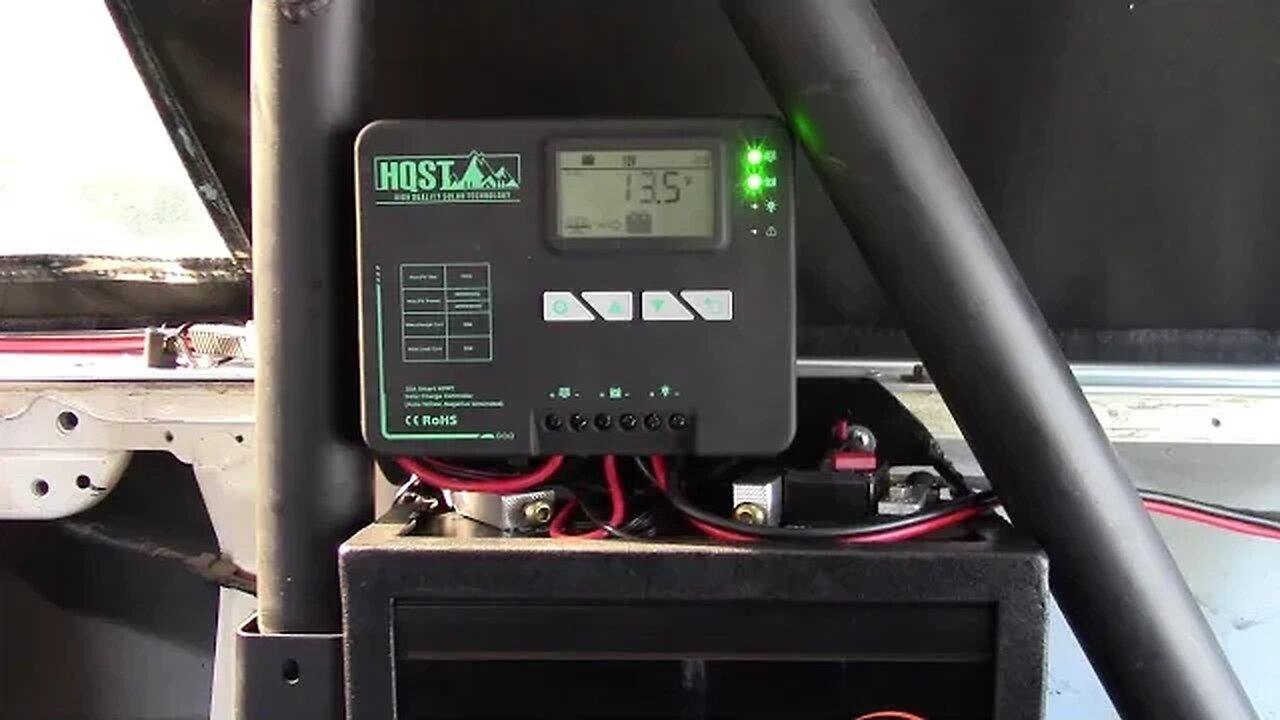Premium Only Content

House Battery and Solar for the 4Runner - Assembled
1st generation Toyota 4Runner, upgrading the power system in the rear of the truck with a 100AH LiFePO4 battery, 20 amp charge controller and 200W solar panel.
With the battery and charge controller installed, I found I didn't have as much vertical clearance as I originally planned. I think this was mainly due to not accounting for the thickness of the steel angle and clearance for the battery in the cage. Had to shrink my battery connections down in height and allow for more rotation to put them in the best orientation. I wanted the circuit breaker to be attached directly to the positive battery terminal for safety. The battery does have a 100A BMS inside that'll cut off above 100A.
I've already re-routed the PV and DC load cables out the back instead of to the side like I had them in the video. Will also shorten the battery cables and I may actually eliminate the extended connection off the breaker and just pre-wire in the positive battery cable to clean up the wiring and also to better protect that wire by putting it as far back as possible.
All the pieces of angle were cut to fit around the battery with 45* cuts on the top and bottom trays and straight 90* cuts for the rest. I used some 1/8"x1" flat bar for the back bottom and sides (so the battery could slide in). The top was a piece of 1/8" x 2" flat bar. I cut clearance notches in that bar to allow the battery terminals to fit under as well as some notches on the upper angle to clear those terminals as well. You can find that sort off steel at most hardware stores or from a supplier like McMaster-Carr or Metal Supermarkets. This is similar to the cage I built to hold my dual batteries many years ago. I welded that cage up at my evening welding class.
This whole cage is designed to fit entirely on top of the wheel well and inside the opening in the factory roll bar. This will keep these components safely out of the way of things moving around in the bed while traversing bumpy 4WD trails and washboard roads. In the past, I used to bring my Harbor Freight jump start pack and always had trouble securing it in back. This new house battery will not be moving anywhere!
Why this charge controller? A few reasons, main one was the size, it fit in the space available. The other reasons were it had a decent feature set, MPPT, 20 amp rating to handle the 200W panel, Lithium and User charging profiles, built-in BlueTooth. HoboTech did a good review on these: https://youtu.be/HySgUYqjmo8?si=QcVw6jD4AhfpRae1
Why not use a commercial "solar generator"? Two main reasons, main one is that I couldn't find anything that would fit the space I had. Second reason was reliability, I have no experience with those systems but it seems that if one part goes out, the whole unit is dead. With the setup I've designed, if the LiFePO4 battery or BMS quits, I can reconfigure the charge controller to use the lead acid batteries. If the charge controller quits, I can use the alternator to charge the LiFePO4 battery, but this will always be in parallel with 1 or both lead acid batteries. I'll run some tests later to determine if a DC-DC charger will be needed for this of it my high output Premier Power Welder alternator can handle this task. When I'm 100 miles from nowhere and something quits, I like to have options to work around the failed item.
Following videos will get into the roof top solar panel mount...
List of parts used:
LiTime Mini 100AH battery:
https://www.litime.com/products/litime-12v-100ah-mini-lifepo4-lithium-battery-upgraded-100a-bms-max-1280wh-energy
https://amzn.to/3QmxcC5
HQST 20A MPPT Charge Controller
https://hqst.refr.cc/rogerb
https://amzn.to/3S5zhnf
200W AllPowers flexible solar panel:
https://amzn.to/46z7Eax
SAE Extension cable, used 3 ft. and 6 ft. cables:
https://amzn.to/46VnLix
SAE bulkhead connector:
https://amzn.to/3tuP7h1
8 circuit power distribution block:
https://amzn.to/45Ia9pL
#4Runner #softtop #lithiumbatteries #solarpanel #chargecontroller #LiTimestory
-
 LIVE
LIVE
vivafrei
1 hour agoWhat Did Bongino See? The Epstein "Privilege"! Canada Has Become a Dangerous JOKE & MORE!
12,413 watching -
 2:07:48
2:07:48
The Quartering
3 hours agoToday's Breaking News With Josie The Red Headed Libertarian, Hannah Claire & Luke Rodkowski
92.4K20 -
 LIVE
LIVE
Dr Disrespect
4 hours ago🔴LIVE - DR DISRESPECT - WARZONE - RAGE ON THE MAIN STAGE
2,014 watching -
 LIVE
LIVE
Akademiks
2 hours agoDrake Tries for another #1?? Kodak vs YB still? Ksoo gets snitched on. Doechii plz stop botting
1,278 watching -
 LIVE
LIVE
The HotSeat
26 minutes agoHate Crimes In Cincy + Hiring A White Girl Makes You A NAZI?!?!
354 watching -
 DVR
DVR
Stephen Gardner
54 minutes ago🔥 RFK Just SHUT DOWN a DISTURBING Problem!
2961 -
 LIVE
LIVE
Film Threat
5 hours agoVERSUS: SUPERMAN VS. THE FANTASTIC FOUR | Film Threat Versus
72 watching -
![[Ep 715] The Trump Way: Deals & Peace | Hate Crimes – Brutal Beat Downs | CA Homeless Money Scam](https://1a-1791.com/video/fww1/f5/s8/1/6/3/j/6/63j6y.0kob-small-Ep-715-The-Trump-Way-Deals-.jpg) LIVE
LIVE
The Nunn Report - w/ Dan Nunn
1 hour ago[Ep 715] The Trump Way: Deals & Peace | Hate Crimes – Brutal Beat Downs | CA Homeless Money Scam
81 watching -
 2:36:55
2:36:55
Nerdrotic
6 hours ago $0.41 earnedCancel Kurtzman Trek | The Fate of the Superhero Film - Nerdrotic Nooner 502
31.9K2 -
 LIVE
LIVE
Viss
3 hours ago🔴LIVE - The Tactics That Lead To Consistent Wins in PUBG!
77 watching